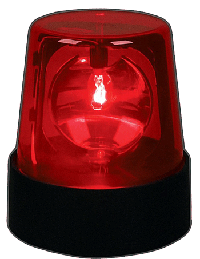Previous posts have talked about functionality that allows data to be collected through the GEM interface so the factory applications described in the most recent post can analyze this data. With this posting, we return to a discussion of specific features and capabilities of the SEMI E30 GEM (Generic Equipment Model) standard, specifically the management of error conditions on the equipment.
In a perfect world everything goes according to plan, but in reality, things always go wrong. The secret to success is being able to know when something goes wrong, and then responding appropriately.
 Just like a home alarm system, semiconductor fabs want to know when something bad has happened. They want to prevent the material being processed from being scrapped. Alarm management enables the equipment to notify the host when something goes wrong, and provide information about what has gone wrong. The GEM standard defines Alarm Management as the capability to provide host notification and management of alarm conditions occurring on the equipment.
Just like a home alarm system, semiconductor fabs want to know when something bad has happened. They want to prevent the material being processed from being scrapped. Alarm management enables the equipment to notify the host when something goes wrong, and provide information about what has gone wrong. The GEM standard defines Alarm Management as the capability to provide host notification and management of alarm conditions occurring on the equipment.
In GEM, an alarm is any abnormal situation on the equipment that may endanger people, equipment, or material being processed. For example, if a technician opens an access panel to replace a component, the equipment should send an alarm notifying the host that it is not safe to operate the equipment in its current condition. Another example might be if an equipment requires a high temperature for processing but a sensor detects a low temperature condition, it should trigger an alarm, since running the process under those conditions could damage the material being processed. It is also the responsibility of the equipment manufacturer to inhibit unsafe activities on the equipment when an alarm condition is present. The equipment manufacturer knows best what specific alarms are required on the equipment to ensure safety for people, equipment and material.
Often it is useful to have more information about the conditions in the equipment at the time an alarm condition occurs. Communicating that additional information to the host is valuable, but cannot be done through the normal Alarm Report Send/Acknowledge messages. To provide a way to get this additional information, GEM requires that two collection events be defined for each possible alarm condition on the equipment – one event for when the alarm is set, and another for when the alarm is cleared. These collection events allow the GEM event data collection mechanisms to be used to send the additional related information to the host when an alarm changes state.
condition occurs. Communicating that additional information to the host is valuable, but cannot be done through the normal Alarm Report Send/Acknowledge messages. To provide a way to get this additional information, GEM requires that two collection events be defined for each possible alarm condition on the equipment – one event for when the alarm is set, and another for when the alarm is cleared. These collection events allow the GEM event data collection mechanisms to be used to send the additional related information to the host when an alarm changes state.
In addition to providing the time of an alarm state change, Alarm Management on the equipment must allow the Host to request a list of all alarm IDs and associated alarm text. The host must also be able to enable/disable individual alarms on the equipment, and query the equipment for the list of alarms that are currently enabled for reporting.
The state diagram for an Alarm is not very exciting, but it fills a vital need. The picture below illustrates the Alarm State diagram:

GEM alarms only have 2 states: each alarm is either SET or CLEAR. It’s simple but effective.
Alarm Management isn’t rocket science, but through effective use of Alarm Management, fabs can carefully monitor the health of their process equipment and minimize negative impacts to their production yield.
Click here to read the other articles in our SECS/GEM Features and Benefits series.
To download a white paper on an introduction to SECS/GEM, Click below:





